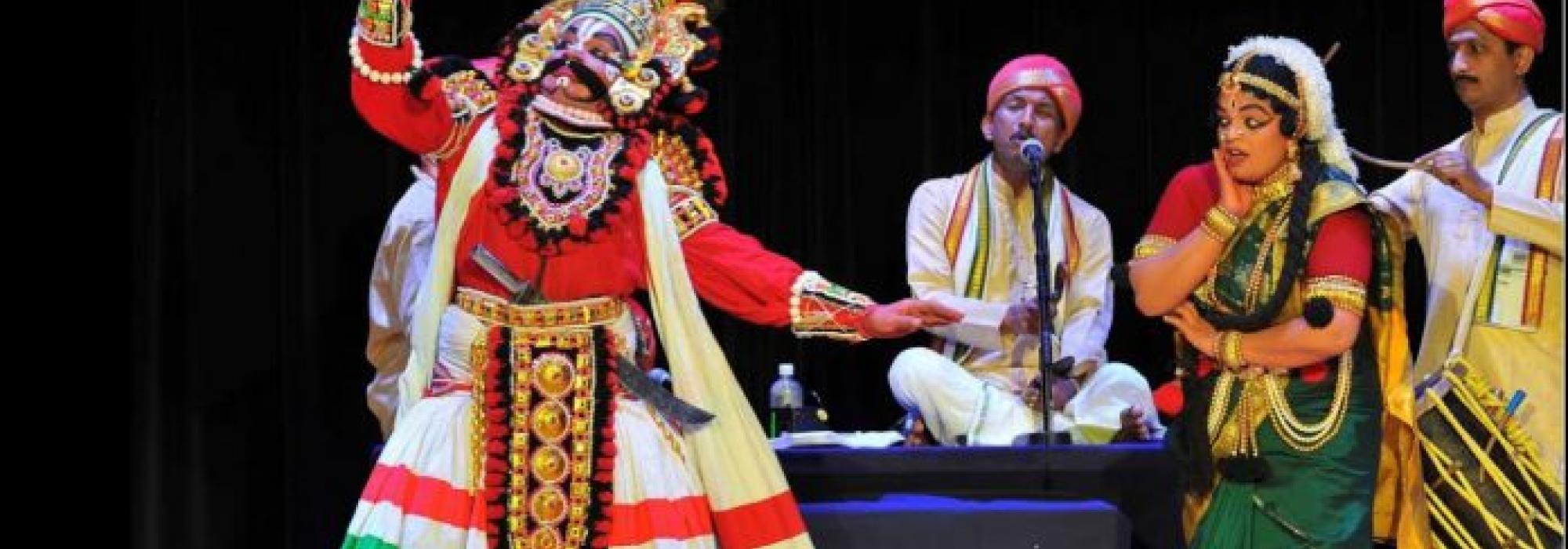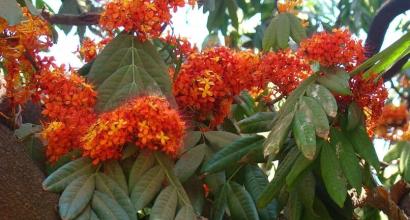Let us examine the qualities that the extempore delivery of dialogues on the stage should ideally possess. Adherence to śruti, though important, is not the only aspect that needs to be cared for. Pronunciation of every syllable should be accurate. Depending on the situation, appropriate words, syllables, and punctuations must be appropriately emphasized. Artistes should modulate their voice as per the emotion that needs to be expressed. In addition to these, pauses, accurate splitting of words, and silences at appropriate places also strengthen emotive expression. It is important to speak in tune with the śruti[1] in a style unique to Yakṣagāna. These aspects are discussed in detail in the Nāṭyaśāstra. Though many artistes have intuitively realised these aspects, not much thought seems to have been given to formalize them as compulsory elements of the art. Workshops must be organized and classes should be conducted for training artistes in dialogue delivery. Such activities must emphasise upon the characteristics of speech mentioned above. Training must also be institutionalized. All schools of Yakṣagāna should include training of vācika as an important element of pedagogy. The hobby and practice assemblies of Tāḻa-maddaḻè are doing a good job in helping young artistes develop speaking skills. Nevertheless, it would be all the more beneficial if a pedagogy was developed for this kind of training. In addition to this, artistes must develop the required amount of erudition to be able to establish characters in an aesthetic manner within the framework of Yakṣagāna – this demands an independent article in itself. In summary, artistes must always keep Rasa as the ultimate goal and ensure that their vācika is sub-servient to Rasa.
~
Let us now examine the aesthetics of dhātu, another important facet of the vācikābhinaya. Dhātu refers to the world of śruti, laya, svara, and tāla. In today’s parlance, these are put together under the head saṅgīta[2]. Many have written in detail about Yakṣagāna-saṅgīta. Shantarama Hegade and Raghava Nambiar have earned their PhDs on the subject. Scholars and artistes such as Srinivasa Udupa, Neelavara Ramakrishnayya, Prof. M. Rajagopalacharya, Keremane Mahabala Hegade, Mandeccha, Balipa, Maambaadi, Uppuru, and Kalinga Navada have contributed tremendously for the refinement of Yakṣagāna-saṅgīta. Nevertheless, we must admit that we are yet to develop an objective and insightful understanding of Yakṣagāna music, its function, and the directions it must take in the future. In my opinion, bringing about reformation in Yakṣagāna-saṅgīta should be of the highest priority today. I say so because, āhārya, āṅgika, and sāttvika depend upon the music and lyrics that accompanies a presentation. The rāga-bhāva (emotion in the rāga) and laya-lāsya (rhythmic exuberance) play predominant roles.
Dr. Shivarama Karantha and Prof. M. Rajagopalacharya have documented seventy to eighty rāgas that were probably in use in the past and have been in vogue in the recent decades in Yakṣagāna[3] recitals. They have also included new rāgas that have been added to the repertoire in the recent years. They have not only made audio recordings of Yakṣagāna music but have also made written documentation.
There has been quite some discussion on the nature of Yakṣagāna-saṅgīta. Many are of the firm opinion that Yakṣagāna-saṅgīta is markedly different form both the Carnatic and Hindustani styles of music. We must analyse further by doing away with our biases, blind admiration and pride. For a school of music to get recognized as a genre, it must have its ‘signature style’. Moreover, the genre should have a good spatio-temporal expanse. In other words, it should have been practised by many people for long periods of time in different places. The style should also be unique and original. This kind of self-sufficiency and self-completeness has been achieved only by two schools that are distinctly recognizable today – Hindustani and Carnatic. The music that accompanies Kūcipūḍi, Kathakaḻī, Kūḍiyāṭṭam, Oḍissī, Sadir, Tamāṣā, Saṇṇāṭa, Nauṭaṅkī, Sattriya, Bhavai, and other regional theatrical forms is a combination of both Hindustani and Carnatic music, i.e., has the elements of both. Raṅga-saṅgīta, i.e., music that accompanies the aforementioned dance and theatre forms are also products of local tastes and necessities of the visual medium. Music is also adapted to the specific context that needs to be presented. At times, raṅga-saṅgīta is also motivated by certain non-aesthetic parameters and thereby, mars the beauty of the presentation, instead of amplifying it. Moreover, raṅga-saṅgīta also depends on the calibre, creativity, erudition, and manodharma of the musicians – vocalists and instrumentalists.
Yakṣagāna-saṅgīta should be considered an adaptation of Carnatic music, instead of treating it as an independent and self-complete genre. I would like to clarify at this point that, by Carnatic or Southern style of music, I am referring to the kind of music that has taken shape from the times of Svāmī Vidyāraṇya of the Vijayanagar period. A unique kind of music accompanies every theatrical art. In fact, more than the specific sub-genre of raṅga-saṅgīta, pure and non-representative gāna-saṅgīta is holistic and self-complete. Pure music is more artistic, comprehensive, and independent.
The following features are considered ‘unique’ to Yakṣagāna-saṅgīta –
• Use of tālas belonging to the chāpu variety – they are simple and are counted only through ghāta (beats on the hand)
• Scarcity of prati-madhyama rāgas[4]
• Limited variety in the elaboration of rāgas and their phrases
• Movement of the rāga largely in the madhyama and tāra-sthāyis (middle and higher octaves), as against the mandra-sthāyi (lower octave)
• Dīrgha-kampita-gamakas (long oscillatory embellishments) on the Sa-Ri-Ga svaras
• Quick sliding from one svara to the other, i.e., quick jārus
• Absence of the madhyama-śruti
• Change of tāla and laya as per the needs of the context
• Freedom with gati – speeds
• Usage of certain stobhākṣaras[5] (non-referential sounds such as ā, vū, ò, o, etc.) – these stobhākṣaras are rendered through strange voice modulations; sometimes times such modulations are intentional and at other times, accidental
However, it must be noted that these and similar features can be found in the music that accompanies Kūcipūḍi, Cindu, Tèrukkūttu, Kṛṣṇāṭṭam, Kathakaḻī, Mūḍalapāya, Keḻikā, Tūrpu Bhāgavatam, Bhāgavata-meḻa, Sopānam, and several other regional forms of theatrical art. Moreover, ‘classical Carnatic’ music had these characteristics over a century ago. We must make a note of the manner in which the music that accompanies regional dance forms has undergone changes as a function of the changes that have taken place in Carnatic music. The music of Kūcipūḍi, Kathakaḻī, Sadir and Bhāgavata-meḻa, for instance, have undergone refinement along with the main stream Carnatic music. We must also examine the manner in which technology has affected theatrical art.[6] Without such critical and objective analysis, it is hard to work towards any kind of refinement. There are, at times, changes that are brought about due to non-artistic reasons and it is possible that artistes and connoisseurs are under the illusion that it is an integral part of the art from. They might also end up being conservative and would want to protect and hold on to the particular feature without any logical or aesthetic reason. This attitude is certainly not welcome.
Upon examining Yakṣagāna-saṅgīta with this background, we discover that there is immense scope for meaningful refinement. Some features that have been lost with time can be brought back and newer additions can be made. Having said so, readers need to note that refinement should happen without any positive or negative biases towards the ancient and the modern. If this is not kept in mind, there can be no refinement at all. Rasa should be our guiding light at all times
This series of articles is authored by Shatavadhani Dr. R Ganesh and have been rendered into English with additional material and footnotes by Arjun Bharadwaj. The article first appeared in the anthology Prekṣaṇīyaṃ, published by the Prekshaa Pratishtana in Feburary 2020.
[1] Here, the concept of śruti is not really connected with the śruti (pitch) of music. In this context, it refers to stylized verbal articulation that resembles the prose passages spoken in katha-kīrtana/ katha-kālakṣepa presentations. This unique tonality treads the middle path between singing and speaking.
[2] Classical treaties such as Saṅgīta-ratnākara define saṅgīta as a combination of gīta, nṛtya, and vādya.
[3] A study of Prof. M Rajagopalacharya’s book would reveal the fact that the notations provided in the work are extremely brief and resemble the skeletal forms of the music of Yakṣagāna. However, none should demean the work of Prof. Rajagopalacharya as it is the only one of its kind till date.
[4] These are rāgas that contain the prati-madhyama-svara (also denoted as ma2 in Carnatic music) in their scale
[5] These are at times, required for the context and at other times quite extraneous to Yakṣagāna. Many a times, they are used by the artistes for no evident aesthetic reason.
[6] Quite a few changes in āhārya, āṅgika, vācika, and sāttvika have occurred primarily because of the progress in technology. Several modifications in these modes of abhinaya have taken place purely due to non-aesthetic reasons as well. It must be borne in mind that any change or addition should be carried out for aesthetic purposes only and not otherwise.







































